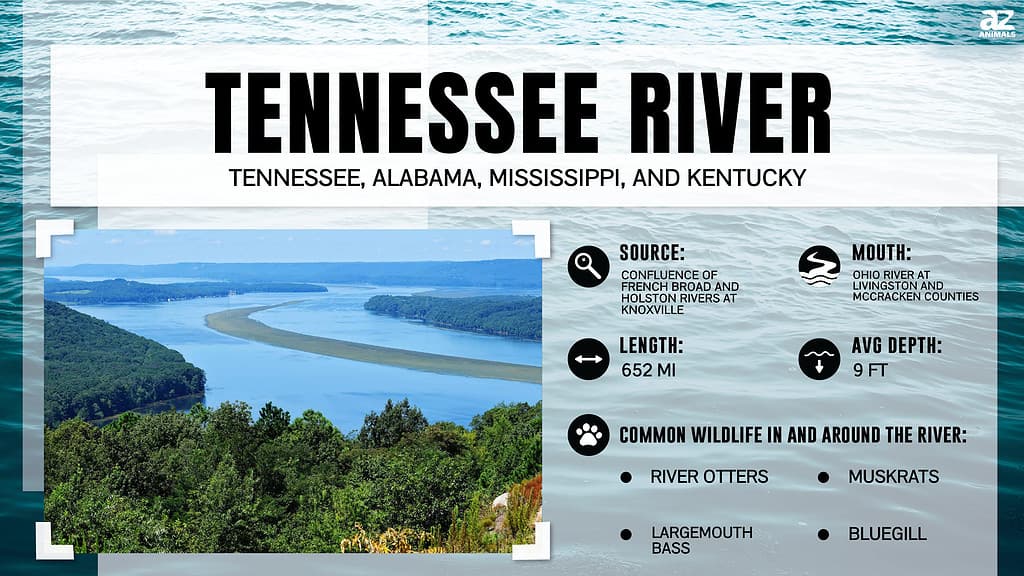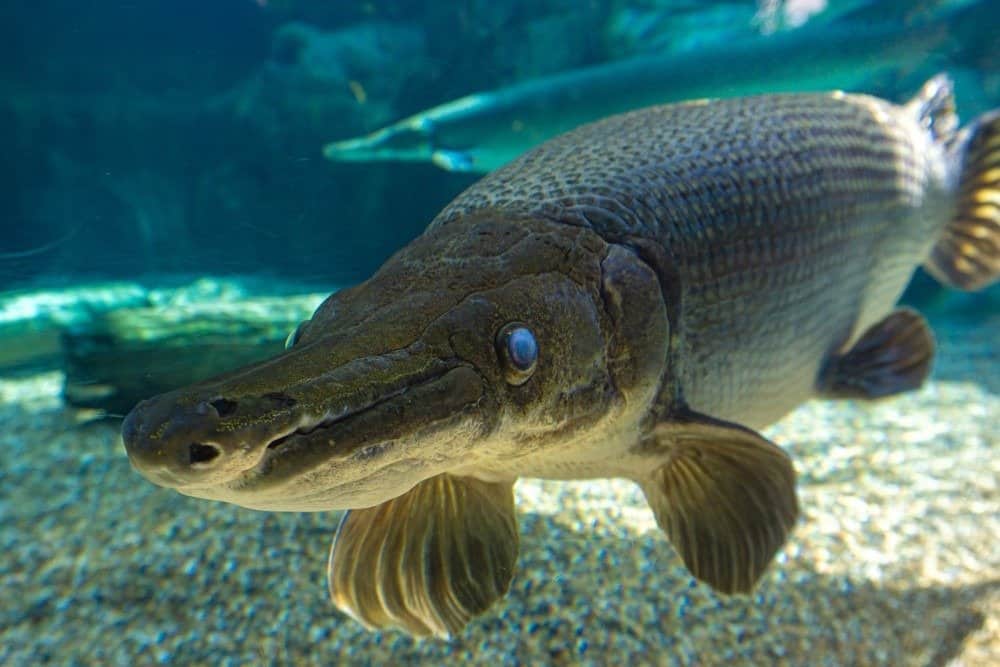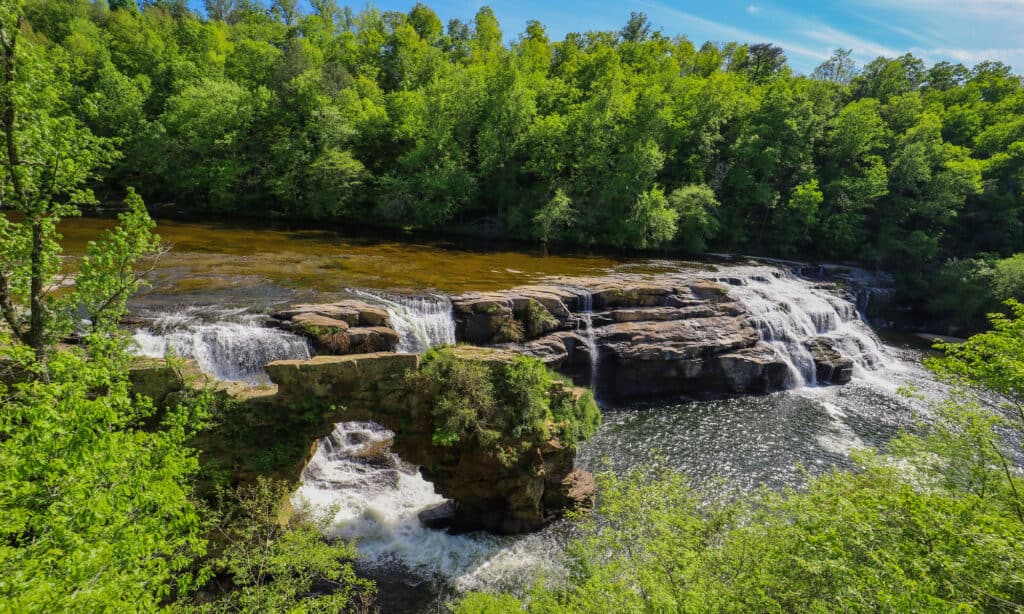
There’s nothing quite like the refreshing feeling of diving into cool, clear water on a hot summer day. And if you’re looking for a unique and beautiful place to swim, look no further than the Tennessee River. With its scenic views and inviting waters, the Tennessee River offers a one-of-a-kind, safe-for-the-most-part swimming experience that you won’t soon forget. But before you grab your swimsuit and head out the door, there are a few things you should know about swimming in the Tennessee River. So, let’s dive in and explore all that this remarkable river has to offer swimmers.

The Tennessee River offers a one-of-a-kind, safe-for-the-most-part, swimming experience that you won’t soon forget.
©Zoran Zeremski/Shutterstock.com
Where is the Tennessee River?
The headwaters of the Tennessee River are in the mountains of East Tennessee. The river is formed by the confluence of the Holston River and the French Broad River. From there, the river flows Southwest through Tennessee, Mississippi, and Alabama before joining the Ohio River in Western Kentucky. The Tennessee River is the largest tributary of the Ohio River and is approximately 652 miles (1049 km) long. It passes through a variety of landscapes, including mountains, forests, farmland, and urban areas. The river also has a significant effect on the region’s economy and ecology. It provides water for industry and agriculture. It also serves as a habitat for a wide variety of fish and wildlife. The mouth of the Tennessee River is located at its confluence with the Ohio River near the town of Paducah, Kentucky.
Where is the Tennessee River Located on a Map?
The Tennessee River begins at the confluence of the Holston and French Broad Rivers in Knoxville, Tennessee, and ends near Paducah, Kentucky, where it flows into the Ohio River. The river flows 652 miles through four states: Tennessee, Alabama, Mississippi, and Kentucky. Huntsville, Alabama, is the largest city on the Tennessee River.
What Is In The Tennessee River?
The Tennessee River is a beautiful and scenic waterway that stretches over 652 miles (1049 km) through five states, offering plenty of opportunities for swimming, boating, and other water activities. However, the dangers that lurk beneath the surface may not be what you might typically expect. While many might assume that the dangers lie in submerged debris or that snakes pose the greatest risks, the real threat to swimmers and the river’s ecosystem is much more insidious: microplastic pollution. Yes, that’s right, tiny pieces of plastic that are invisible to the naked eye are causing significant harm to both the river and those who swim in it.

Sunset over the Tennessee River in Huntsville, Alabama.
©/Shutterstock.com
What’s in The Tennessee River: Microplastics
Dr. Andreas Fath, a German professor of physical chemistry, swam the entire length of the Tennessee River in 2017, covering 652 miles(1049 km) in 34 days. During his journey, he collected water samples and data to study the water quality and pollution levels in the river. Dr. Fath’s research revealed high levels of microplastic pollution in the Tennessee River, which have negative effects on both aquatic ecosystems and human health. According to his findings, the river had an average of over 100,000 microplastic particles per cubic meter of water, which is among the highest levels of microplastic pollution ever recorded in freshwater systems. Microplastic pollution is a growing environmental concern.
What’s in The Tennessee River: Beyond Microplastics
Wildlife
The Tennessee River is home to a variety of fish species. Some of the common fish species found in the Tennessee River include:
- Smallmouth Bass
- Largemouth Bass
- Channel Catfish
- Blue Catfish
- Flathead Catfish
- Bluegill
- Crappie
- Sauger
- Walleye
- Paddlefish
- Sturgeon
- Striped Bass
- White Bass
- Yellow Perch
- Rainbow Trout
The Tennessee River is a diverse ecosystem that supports a wide range of aquatic life. While there are some potentially dangerous animals in the Tennessee River, the risk of encountering them is generally low if proper precautions are taken, such as wearing appropriate footwear, being aware of your surroundings, and avoiding swimming in areas where these animals are present. Some of the potentially dangerous animals that can be found in the Tennessee River include:
- Alligator Gar (Atractosteus spatula) – These fish have sharp teeth and can grow up to 300 pounds. While they are not typically aggressive toward humans, they can be dangerous if provoked.
- Snapping Turtles (Chelydra serpentina) – These turtles can have very powerful bites and should be approached with caution.
- Water Moccasins (Agkistrodon piscivorus) – Also known as cottonmouths, these venomous snakes can be found in and around the Tennessee River. While they are not typically aggressive, they can be dangerous if provoked.
- Copperheads (Agkistrodon contortrix) – These venomous snakes can also be found in the area surrounding the Tennessee River.

The
alligator
gar (
Atractosteus spatula) has sharp teeth and can grow up to 300 pounds but is not typically aggressive toward humans.
©TKBackyard/Shutterstock.com
Inorganic Matter
While wildlife may be the principal danger one might associate with swimming in untamed waters, there are other clear and present dangers lurking within the swell. Like heavy metals. Some areas of the Tennessee River have been affected by industrial activity, which has resulted in the presence of heavy metals such as lead, mercury, and cadmium in the water and sediment. Agricultural runoff has introduced pesticides and herbicides into the Tennessee River. The discharge of untreated sewage and wastewater, principally from tributaries, has introduced potentially harmful pathogens and bacteria into the Tennessee River. And then there are the aforementioned microplastics. Microplastics, which are tiny plastic particles, have been found in the Tennessee River, posing a risk to fish and wildlife.

Agricultural runoff has introduced pesticides and herbicides into the Tennessee River.
©Fotokostic/Shutterstock.com
Navigational Hazards
Beyond the wildlife and the inorganic matter, swimmers must consider the navigational hazards associated with swimming in the Tennessee River. The Tennessee River features several rapids, particularly in the upper stretches of the river. These rapids can be dangerous for inexperienced swimmers or those who are not familiar with the area. The river is known for having a rocky bottom in some areas, which can create unbalanced footing. There may also be submerged obstacles, such as logs that are not visible from the surface of the water. The Tennessee River is a heavily trafficked waterway, and swimmers need to be on the lookout for buoys, markers, and boaters. It’s paramount for swimmers to take appropriate precautions to avoid these and other potential hazards. This can include wearing appropriate safety gear and staying within the bounds of designated swimming areas.

The High Falls are part of the Tennessee River and provide an impressive sight when the river is flowing.
©Gabriel Quiles/Shutterstock.com
Is It Safe to Swim In the Tennessee River?
Generally speaking, the Tennessee River is considered safe for swimming. However, it’s important to note that the river also contains potential hazards such as strong currents, deep areas, and submerged obstacles. Some parts of the Tennessee River may be affected by pollutants, such as agricultural runoff, sewage discharge, industrial waste, and microplastics, which could potentially render the water unsafe for swimming. But overall, the Tennessee River is safe to swim in.

Generally speaking, the Tennessee River is considered safe for swimming.
©iStock.com/master1305
Best Bets
The Tennessee River is a major river in the Southeastern United States, and its water is used for a variety of purposes, including drinking water, irrigation, and hydroelectric power generation. As a result, many reservoirs have been created along the river to help manage its water flow and usage. These reservoirs offer recreational opportunities, including swimming, in addition to their primary functions. If you’re planning to take the plunge, some of the more swimmer-friendly areas on the Tennessee River include:
- Pickwick Landing State Park: Located in Counce, Tennessee, Pickwick Landing State Park has a sandy swimming beach area along Pickwick Lake.
- Joe Wheeler State Park: Located in Rogersville, Alabama, Joe Wheeler State Park has a designated swim beach area on Wheeler Lake.
- Guntersville State Park: Located in Guntersville, Alabama, Guntersville State Park has a public beach area on Guntersville Lake for swimming.
- Nickajack Lake, in Guild, Tennessee, has several public access points and beaches along the lake where visitors can swim and enjoy the water.
- Watts Bar Lake, in Kingston, Tennessee, has the Watts Bar Dam Reservation, which is located on the East side of the lake, where a sandy beach and designated swimming area await swimmers.
The photo featured at the top of this post is © Tracy Burroughs Brown/Shutterstock.com
Thank you for reading! Have some feedback for us? Contact the AZ Animals editorial team.






